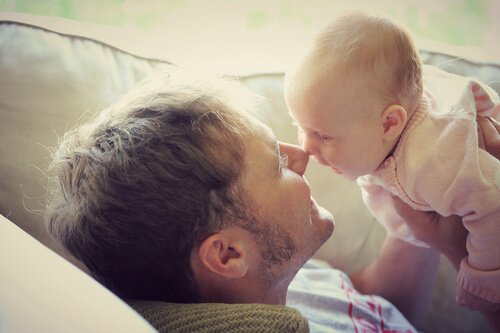The Babinski reflex is a primary reflex in babies. In other words, it’s an automatic response from the moment of birth. It’s kind of like other known reflexes, such as sucking. It ensures their survival. But what is it exactly?
Today’s article will show you how professionals evaluate the Babinski reflex, as well as when to use it to evaluate a possible anomaly.
“A first child is your own best foot forward. And how you do cheer those little feet as they strike out.”
-Barbara Kingsolver-
Primary reflexes in infants
Reflexes are automatic responses triggered by an external stimulus. French physician Jean Astruc, who compared these automatic reactions to the impact of a light beam in a mirror, coined the term.
Both health professionals and parents closely monitor these reflexes. The main reason is that they directly register neurological health and possible future problems in an infant. In fact, the Apgar score evaluates them as a direct indicator of a newborn’s health.
The baby’s primary reflexes are those produced at birth and will subsequently disappear. Grasping objects with their fingers, the sucking that facilitates the production of breast milk, and swimming and the Babinski reflexes are among them. Today’s article will discuss the latter in more detail.
The Babinski reflex
Also known as the baby’s plantar reflex, as it triggers when you rub the sole of their foot with a flat instrument. What happens is the baby automatically creates an extensor reflex in the hallux, colloquially known as the “big toe”. As a result, the rest of the toes will simultaneously fan out.
The reason for the Babinski reflex in infants, and in most mammals, is for foot protection. In fact, this movement can extend to other lower extremities, such as the legs. Furthermore, the polysynaptic pathways in the spinal cord control it.
One can use other variants to corroborate the Babinski reflex after obtaining an ambiguous reflex response. One of them can be the stimulation of the Achilles heel, better known as Schaefer’s variant. Similarly, the Gordon variant reflex can replace the Babinski one. It consists of exerting pressure on the infant’s calf muscles.
The Babinski reflex is either a sign of normalcy or an anomaly
As we mentioned above, the Babinski reflex is present in infants from birth. It tends to disappear at around twelve months of age. However, it can last up to the second year of age.
Babies haven’t yet reached enough biological maturity and, precisely for this reason, they do this reflex. Its absence in the early years is due to a disorder of the central nervous system or the spinal cord. Some developmental delays or spinal cord injuries, among others.
Infants reach sufficient biological maturity and develop the negative Babinski reflex, which stays all the way through adulthood. In this case, the same plantar pressure leads to a reflex in which the toes turn inward and the heel bone moves away from the centerline of the leg. As in infants, the absence of the negative Babinski effect in adults is due to nervous system diseases.

The Babinski reflex: instinctive strength in infants
As you can see, primary reflexes in infants are those responses beyond the infant’s control and appear from the moment of birth. These primary reflexes have a primitive function that promotes infant survival. Therefore, its biological baggage preserves the human species.
This reflex activates when you apply pressure on the baby’s plantar area. It leads to an automatic response of extension and fanning out of the toes. There are other alternatives when detecting ambiguities in this response, such as Gordon or Schaefer variant reflexes.
After two years of age, this reflex transforms into the negative Babinski reflex. Plantar stimulation now produces flexion and not extension. The fact that the two variants occur at a different developmental age are signs of conditions related to the central nervous system or spinal cord.
Reflexes in infants and adults, such as the Babinski reflex, highlight the human instinct for survival. In fact, infants are one of the most biologically immature species. However, primary reflexes demonstrate that they’re somehow also prepared for adversity. In conclusion, babies aren’t as fragile as you may think.
Learn about Infant Communication
The post Description and Characteristics of the Babinski Reflex appeared first on Exploring your mind.













Comments